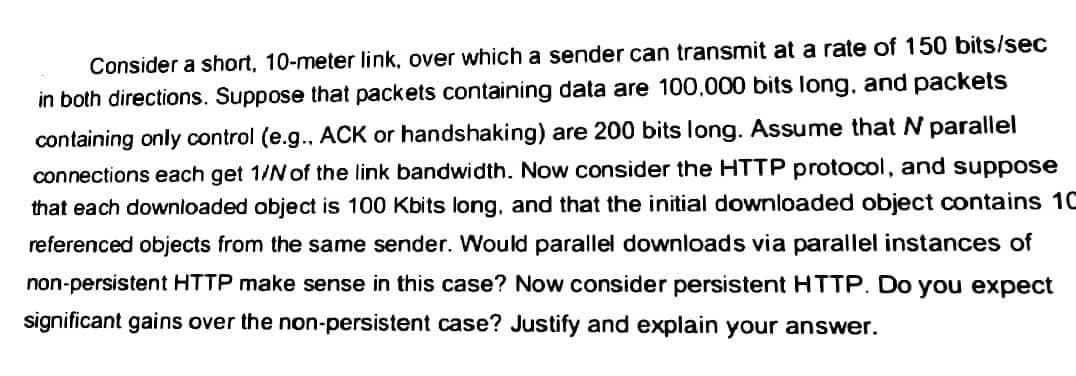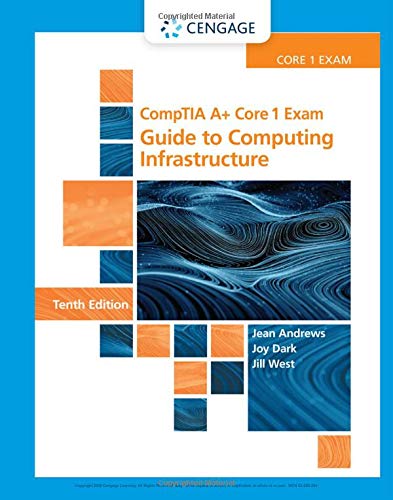Consider a short, 10-meter link, over which a sender can transmit at a rate of 150 bits/sec in both directions. Suppose that packets containing data are 100.000 bits long, and packets containing only control (e.g.. ACK or handshaking) are 200 bits long. Assume that N parallel connections each get 1/N of the link bandwidth. Now consider the HTTP protocol, and suppose that each downloaded object is 100 Kbits long, and that the initial downloaded object contains 10 referenced objects from the same sender. Would parallel downloads via parallel instances of non-persistent HTTP make sense in this case? Now consider persistent HTTP. Do you expect significant gains over the non-persistent case? Justify and explain your answer.
Consider a short, 10-meter link, over which a sender can transmit at a rate of 150 bits/sec in both directions. Suppose that packets containing data are 100.000 bits long, and packets containing only control (e.g.. ACK or handshaking) are 200 bits long. Assume that N parallel connections each get 1/N of the link bandwidth. Now consider the HTTP protocol, and suppose that each downloaded object is 100 Kbits long, and that the initial downloaded object contains 10 referenced objects from the same sender. Would parallel downloads via parallel instances of non-persistent HTTP make sense in this case? Now consider persistent HTTP. Do you expect significant gains over the non-persistent case? Justify and explain your answer.
Comptia A+ Core 1 Exam: Guide To Computing Infrastructure (mindtap Course List)
10th Edition
ISBN:9780357108376
Author:Jean Andrews, Joy Dark, Jill West
Publisher:Jean Andrews, Joy Dark, Jill West
Chapter8: Network Infrastructure And Troubleshooting
Section: Chapter Questions
Problem 8TC
Related questions
Question

Transcribed Image Text:Consider a short, 10-meter link, over which a sender can transmit at a rate of 150 bits/sec
in both directions. Suppose that packets containing data are 100.000 bits long, and packets
containing only control (e.g.. ACK or handshaking) are 200 bits long. Assume that N parallel
connections each get 1/N of the link bandwidth. Now consider the HTTP protocol, and suppose
that each downloaded object is 100 Kbits long, and that the initial downloaded object contains 10
referenced objects from the same sender. Would parallel downloads via parallel instances of
non-persistent HTTP make sense in this case? Now consider persistent HTTP. Do you expect
significant gains over the non-persistent case? Justify and explain your answer.
Expert Solution
This question has been solved!
Explore an expertly crafted, step-by-step solution for a thorough understanding of key concepts.
Step by step
Solved in 3 steps with 3 images

Knowledge Booster
Learn more about
Need a deep-dive on the concept behind this application? Look no further. Learn more about this topic, computer-science and related others by exploring similar questions and additional content below.Recommended textbooks for you

Comptia A+ Core 1 Exam: Guide To Computing Infras…
Computer Science
ISBN:
9780357108376
Author:
Jean Andrews, Joy Dark, Jill West
Publisher:
Cengage Learning

A+ Guide To It Technical Support
Computer Science
ISBN:
9780357108291
Author:
ANDREWS, Jean.
Publisher:
Cengage,

Principles of Information Security (MindTap Cours…
Computer Science
ISBN:
9781337102063
Author:
Michael E. Whitman, Herbert J. Mattord
Publisher:
Cengage Learning

Comptia A+ Core 1 Exam: Guide To Computing Infras…
Computer Science
ISBN:
9780357108376
Author:
Jean Andrews, Joy Dark, Jill West
Publisher:
Cengage Learning

A+ Guide To It Technical Support
Computer Science
ISBN:
9780357108291
Author:
ANDREWS, Jean.
Publisher:
Cengage,

Principles of Information Security (MindTap Cours…
Computer Science
ISBN:
9781337102063
Author:
Michael E. Whitman, Herbert J. Mattord
Publisher:
Cengage Learning

Systems Architecture
Computer Science
ISBN:
9781305080195
Author:
Stephen D. Burd
Publisher:
Cengage Learning

A+ Guide to Hardware (Standalone Book) (MindTap C…
Computer Science
ISBN:
9781305266452
Author:
Jean Andrews
Publisher:
Cengage Learning